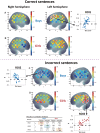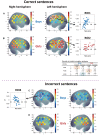Explicit Performance in Girls and Implicit Processing in Boys: A Simultaneous fNIRS-ERP Study on Second Language Syntactic Learning in Young Adolescents
- PMID: 29568265
- PMCID: PMC5853835
- DOI: 10.3389/fnhum.2018.00062
Explicit Performance in Girls and Implicit Processing in Boys: A Simultaneous fNIRS-ERP Study on Second Language Syntactic Learning in Young Adolescents
Abstract
Learning a second language (L2) proceeds with individual approaches to proficiency in the language. Individual differences including sex, as well as working memory (WM) function appear to have strong effects on behavioral performance and cortical responses in L2 processing. Thus, by considering sex and WM capacity, we examined neural responses during L2 sentence processing as a function of L2 proficiency in young adolescents. In behavioral tests, girls significantly outperformed boys in L2 tests assessing proficiency and grammatical knowledge, and in a reading span test (RST) assessing WM capacity. Girls, but not boys, showed significant correlations between L2 tests and RST scores. Using functional near-infrared spectroscopy (fNIRS) and event-related potential (ERP) simultaneously, we measured cortical responses while participants listened to syntactically correct and incorrect sentences. ERP data revealed a grammaticality effect only in boys in the early time window (100-300 ms), implicated in phrase structure processing. In fNIRS data, while boys had significantly increased activation in the left prefrontal region implicated in syntactic processing, girls had increased activation in the posterior language-related region involved in phonology, semantics, and sentence processing with proficiency. Presumably, boys implicitly focused on rule-based syntactic processing, whereas girls made full use of linguistic knowledge and WM function. The present results provide important fundamental data for learning and teaching in L2 education.
Keywords: adaptive hemodynamic response function; phrase structure; proficiency; reading span test; sentence; sex differences; syntax; working memory.
Figures






Similar articles
-
Effects of sex and proficiency in second language processing as revealed by a large-scale fNIRS study of school-aged children.Hum Brain Mapp. 2015 Oct;36(10):3890-911. doi: 10.1002/hbm.22885. Epub 2015 Jul 3. Hum Brain Mapp. 2015. PMID: 26147179 Free PMC article.
-
An Event-related Potential Study of Second Language Semantic and Syntactic Processing: Evidence From the Declarative/Procedural Model.Basic Clin Neurosci. 2020 Nov-Dec;11(6):841-854. doi: 10.32598/bcn.11.6.2401.1. Epub 2020 Nov 1. Basic Clin Neurosci. 2020. PMID: 33850621 Free PMC article.
-
Implicit and explicit second language training recruit common neural mechanisms for syntactic processing.J Cogn Neurosci. 2013 Jun;25(6):936-51. doi: 10.1162/jocn_a_00354. Epub 2013 Apr 22. J Cogn Neurosci. 2013. PMID: 23631551 Free PMC article.
-
Second language syntactic processing revealed through event-related potentials: an empirical review.Neurosci Biobehav Rev. 2015 Apr;51:31-47. doi: 10.1016/j.neubiorev.2015.01.010. Epub 2015 Jan 19. Neurosci Biobehav Rev. 2015. PMID: 25614131 Review.
-
Language representation and working memory with bilinguals.J Commun Disord. 2003 May-Jun;36(3):233-40. doi: 10.1016/s0021-9924(03)00022-4. J Commun Disord. 2003. PMID: 12742670 Review.
Cited by
-
Language Familiarity and Proficiency Leads to Differential Cortical Processing During Translation Between Distantly Related Languages.Front Hum Neurosci. 2021 Feb 26;15:593108. doi: 10.3389/fnhum.2021.593108. eCollection 2021. Front Hum Neurosci. 2021. PMID: 33716689 Free PMC article.
References
-
- Bauer D., Goldfield B., Reznick S. (2002). Alternative approaches to analyzing individual differences in the rate of early vocabulary development. Appl. Psycholinguist. 23 313–335. 10.1017/S0142716402003016 - DOI
LinkOut - more resources
Full Text Sources
Other Literature Sources

